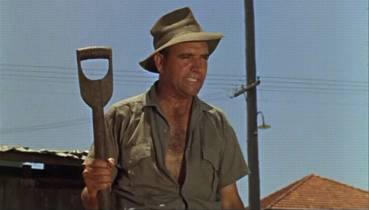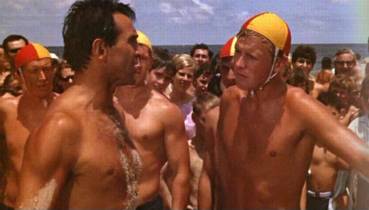| "The hilarious best-seller now becomes... the
funniest film ever made about Australians!" |
| Tagline
for the movie |
| "For the first time I think that the film industry might have a chance here." |
| Chips
Rafferty, actor |
Chips
may have had a point although it wasn't until the mid
to late seventies (a full decade after Powell's movie)
that Australia made a firm footprint on world cinema.
If my surprise at a black and white classic had been,
up to now, the biggest jolt of this box set, along comes They're A Weird Mob to shake me up even
further. Let me step out of the review for a second.

If
you want to show people how good a particular beloved
TV series is, you usually (like myself) make the mistake
of showing them the series' best episodes. Buffy, West Wing, Firefly and Cheers (for example) all thrived on the
cumulativeness (and there is such a word) of character,
of plot – and those aspects rewarded more and more week
after week (or if you're like me, box-set after box-set).
Movies can't do that but groups of movies can hoodwink
you into thinking that certain film makers make certain
films. Of course, this is the horror of expectation and
having a belief system, dagnab it. Slarek once remarked
that when he sat waiting for the curtains to open (in
the cinema, his butler does it for him at home), he felt
grateful if there was any image there at all. It was a
way of denying all expectation and seeing what the film
maker had to show.
Nowadays,
that's practically impossible of course because the reason
you're in that cinema seat is probably a teasing of expectation
(teasing my arse, you are pounded by marketing these days).
The 'subtle sell' passed it's expiration date quite a
few years ago. I was going to use the UK phrase 'sell
by date' but figured 'expiration date' would bring in
more hits. I'm such a whore. My point is that P&P
make masterpieces (I know, I've seen them!) and I'd not
allowed them a 'career', a body of work that like everyone's,
has ups and downs and in the case of P&P, aspects
of sideways and pan dimensional inside outs.
Simply
put, I'd not allowed them to fail.
They're
A Weird Mob is a fish out of water story (based
on the 1957 best selling novel by John O'Grady) of an
Italian immigrant who's hoodwinked into coming to Sydney
and is taken in by his co-workers and finds romance. Again,
I sat there with my jaw lolling unattractively as Nino
Culotta stumbles from one misadventure to another. But
– as an Australian friend reminded me – They're
A Weird Mob (or TAWM) was the
first time Australians had seen themselves represented
on screen and it was enough of a revelation to make the
movie a success. No one had presented the immigrant-to-Australia's
case before and in TAWM, Nino Culotta
(a pseudonym for novelist O'Grady himself) serves as the
everyman through which Australia is presented.
Powell
is as playful here as he's ever been but he's dealing
with stereotypes and perceived national traits and we
all know now that political correctness has bleached that
area of comedy out of existence. But this was the sixties
and taking a warm-hearted look at a curious nation which
sees women as 'Sheilas', uses the phrase 'fair dinkum'
and drinks a lot etc. etc, was a real eye opener at the
time. Forty years on, it's dated rather badly because
it's become less funny due to fashion and social change.
Now Australia may still be like the 'dahn unda' featured
in TAWM but I find that a difficult sell.
Maybe those are my prejudices coming through. Maybe I
just hope that Australia isn't like TAWM anymore. Powell opens his tale with a look at all the
stereotypes, literally presenting down under upside down
on screen (hey ho).

If
the movie works as a delightfully simple romance, it's
because of Walter Chiari's performance. As the immigrant
at the centre of the story, he is completely guileless,
so effortlessly honest and charming that even when the
locals are taking the piss, Chiari manages to squeeze
through the cracks of their rough edges and he fits right
in. He arrives in Australia believing he is taking up
the post of sports editor on a local newspaper run by
his cousin. Alas, his cousin has fled leaving debts and
an attractive debtor whom Chiari vows to pay back. It's
that simple really. Chiari beds down at the former offices
of the newspaper constructing a bizarre, old-newspaper
based lifestyle. He uses newspapers as a towel which is
just mad and makes me wince just remembering it. He divides
any money he makes (manual labour is his only recourse)
into three, a third of which will be paid back until he
has managed to repay the debt. The length of time Powell
takes to show Nino starting his physical labour would
not even qualify as a 'rough cut' these days.
Generally,
the pace at which Powell tells Nino's entire story is,
by today's standards, slow. But that's part of the film's
charm, its 'old world' feel. It's almost possible, while
watching it, to still believe in that world of 'eyeties'
and drunken nationalists. I find it curious that to take
a good look at the Australians, an Italian is chosen as
a cipher. Nino is taken in by his boss, played with an
easy going charm, by Ed Devereaux. His face was awfully
familiar, being the star of the sixties' most famous Australian
TV export, Skippy The Bush Kangaroo.
The movie is liberally sprinkled with all manner of soon
to be famous Australian faces. Popping up as himself for
a cameo is Graham Kennedy, the Australian "King of
TV" thanks to a long running show which showcased
his comic talents. I was introduced to Kennedy as the
middle aged cuckold in Don's Party, another movie that
takes a look at Australians, but in a much more cynical
fashion than TAWM. Kennedy died earlier
this year but his presence in Powell's movie must have
been a coup, signifying to any Australian watching that
this movie has credentials. He actually uses the phrase
"They're a weird mob," demonstrating the rivalry
between Sydney and Melbourne.
Nino
gets the girl and is folded neatly into what was an alien
world at the start of his adventure. It's a weird film
but it has its charms and they're mostly Chiari's.
It's
1966 and we've moved on a bit but although we have a 1.76:1
widescreen presentation, but not anamorphic, presumably
in keeping with the rest of the box set. But the colour
is nicely saturated and the contrast spot on resulting
in deep blacks and a contrast ratio which is pleasing
to the eye. The Dolby 2.0 soundtrack is mostly free from
hiss and is a solid mono transfer. The sub-titles are
basic but there's nothing wrong with that.
Extras?
No extras. It's a miracle it's on DVD in the first place.
|